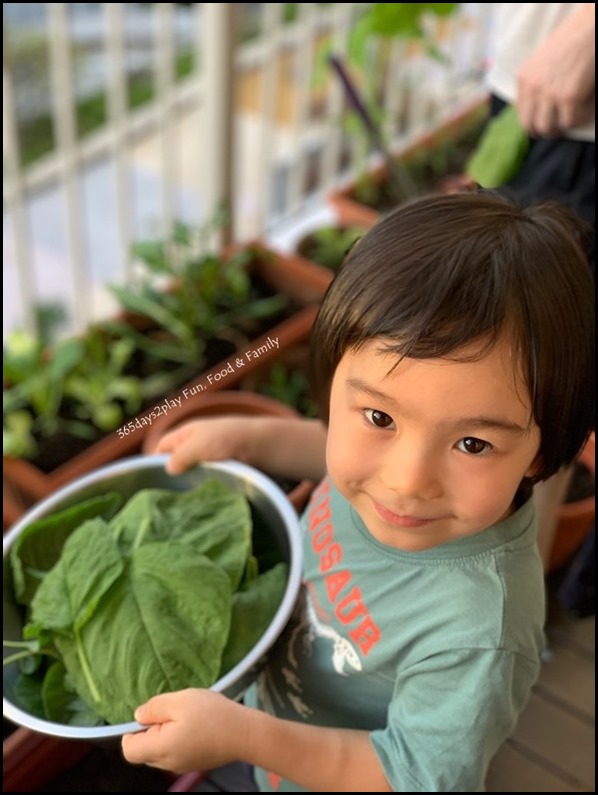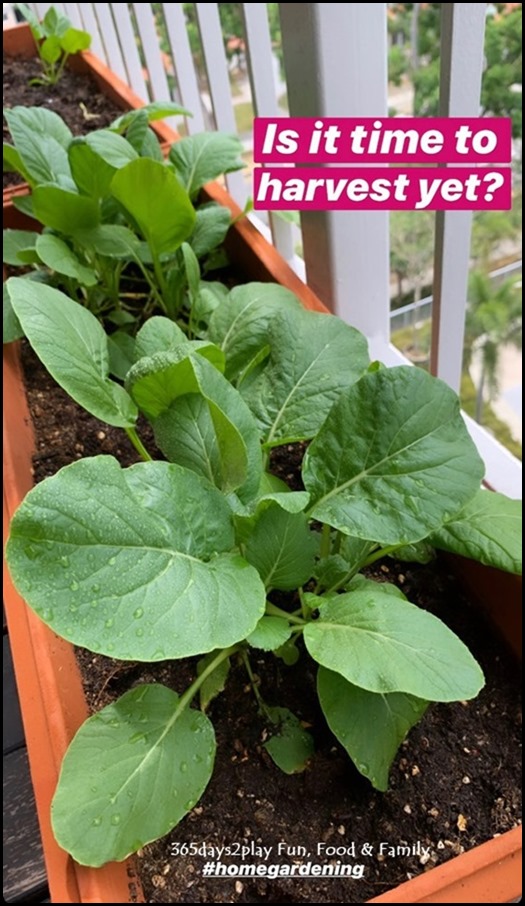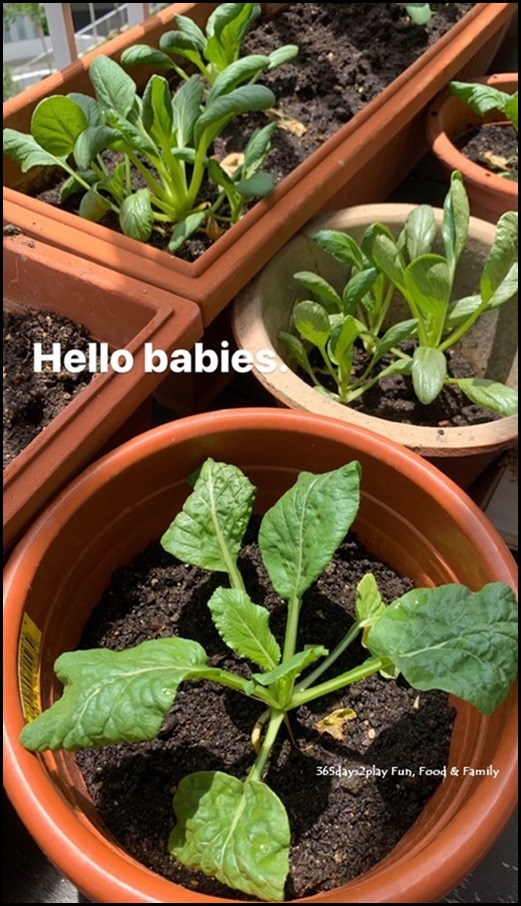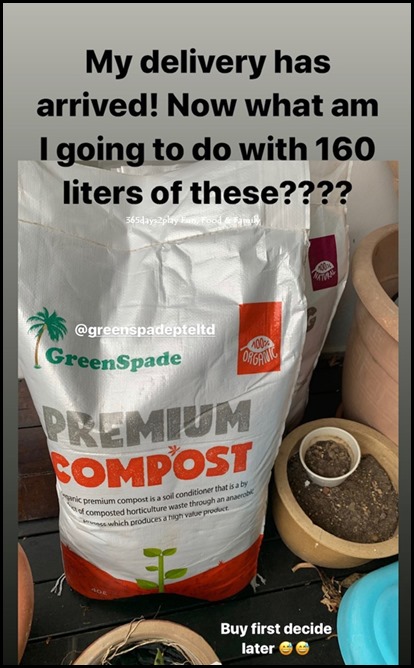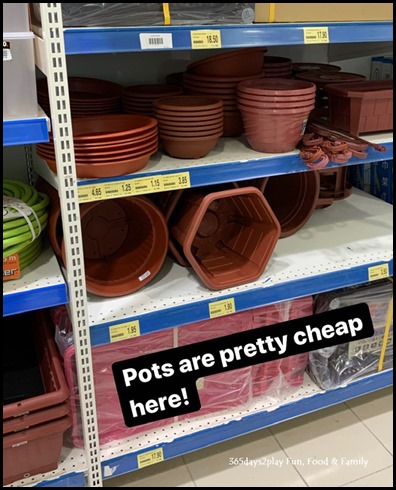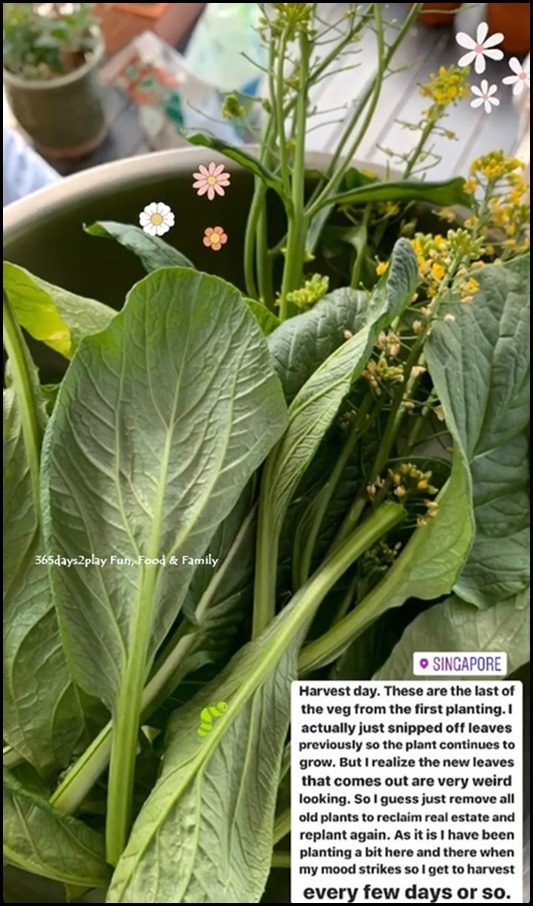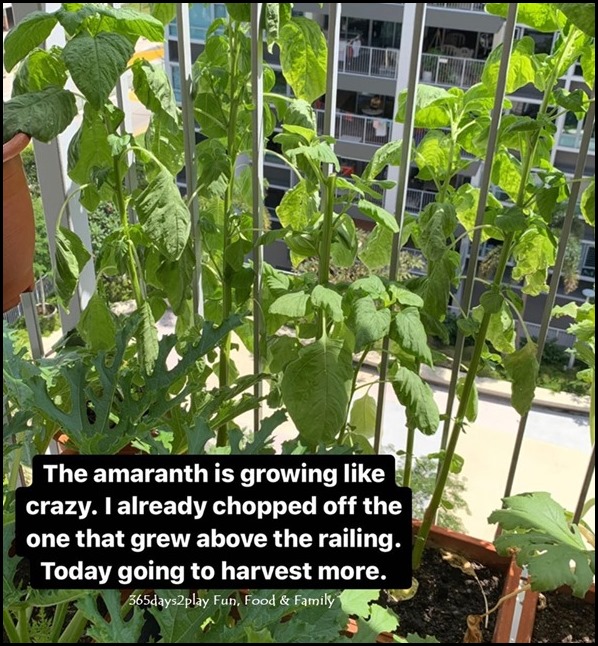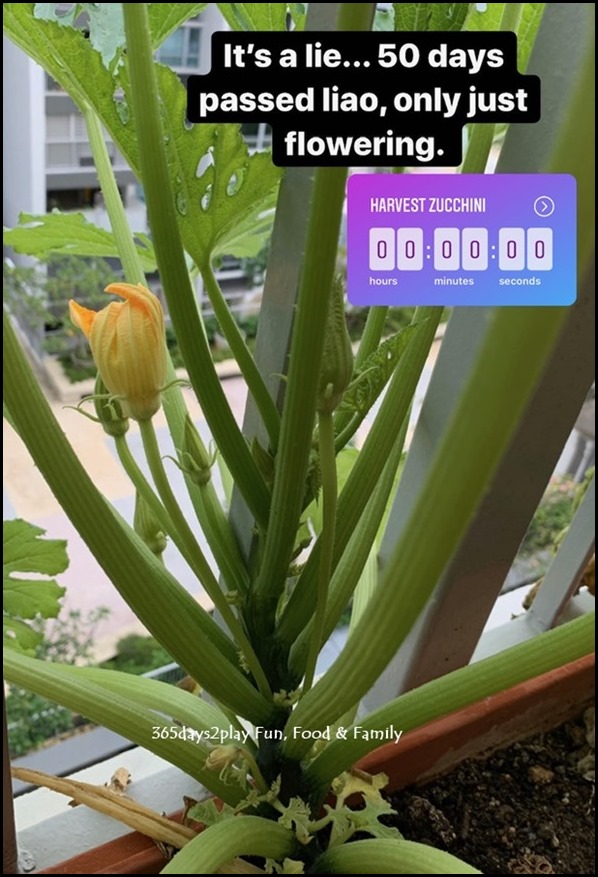The other day over a cup of coffee, I was enthusiastically regaling my gardening trials to a friend, when she suggested that I perhaps compile my woes into a blog post for people who are gardening for the first time. It had never occurred to me to do so as I consider myself very new to gardening (less than a year?) as compared to those who have done it for decades, and with a much larger garden.
But on second thoughts, I agree there is still much to share and much to be learnt despite numerous articles out there catered to the newbie gardener.
Balcony gardening is fun! Just look at this happy happy little gardener! He did proclaim that he will help to harvest but not to eat the greens!
The whole problem is that when something happens to your plant, such as it having crumpled leaves, or it not flowering, many reasons are offered and you’re none the wiser as to which reason was the cause of the problem. Also, a lot of the advice is generic and may not apply to the type of plant you have, whether it be potted or garden grown and very importantly, locality. Worst of all, the effects of whatever wrong doing you might have inflicted on your plant may take days to be visible, if at all.
So here’s what I learnt from balcony gardening living in tropical and humid Singapore, where day temperatures are in excess of 30 degress most parts of the year. I’ve been planting mainly edible plants, with the bulk being green leafy vegetables. You can follow me on Instagram or Facebook to get live updates!
It’s quick and easy to grow leafy greens!
First of all, despite the apocalyptic sounding introduction paragraphs above, it’s actually surprisingly easy to grow leafy vegetable in pots. All the people I’ve shared my photos with are amazed that I grew all these vegetables. Our ultra urban setting has led us to believe that it is difficult, but really, it’s much simpler than you think. Simply get a pot, put potting soil, put seeds and water daily. Don’t let the vegetables dry out. Simple as that! Best to have at least 6 hours of direct sunlight, but lesser is still okay. Even if you do some things wrong, you’re sure to get something to harvest after 30 days or so.
But of course if you want the lushest of vegetables every single harvest, that’s where the problems step in. I’ll first give you a chronological account of what I have been doing to my garden this year, followed by a list of tips on what to do or what not to do when growing leafy vegetables.
Background Story
Around February this year, I planted my first batch of leafy green veggie plants, which happens to be Cai Xin. They grew wonderfully well. The leaves were all broad and lush. It was a joy to watch them grow bigger everyday. I harvested them around mid March. I did leave some to flower and seed, but none of the seed ever sprouted. I then planted my second batch of Cai Xin, but surprisingly, none of them sprouted! After a couple of weeks of waiting, I decided to plant Bok Choy and thankfully, they germinated and grew. Some of them grew very well, and had firm, beautiful and blemish free leaves. However, some others (in different pots)were stunted looking with the leaves only being 1/4 of the broadness of the good leaves. They also had pale streaks on them and just looked very stiff and "air fried" looking. They eventually grew up and I harvested them to eat, but they weren’t as nice looking as the blemish free ones, although they tasted the same.
I decided to plant more Cai Xin again after that, and this time round, the seeds seem to germinate! I have no idea why they did not germinate the previous round but I’ve come to the conclusion that perhaps they dried out possibly due to a couple of hot days. I’ve been more religious in my watering since then and the problem hasn’t returned.
1. Get started! The earlier the better
Alot of people are put off from gardening because they think it will take months of hard work before they can see the fruits of their labour. But actually, there are plants out there that can be harvested after just ONE month! Many leafy greens only require 1 to 2 months before they are ready for harvesting. When I tell people that I can harvest my Cai Xin in 1 month, their eyes always seem to pop out and they’ll say SO FAST? YES it is that fast. And the more you hum and haw, that’s yet another harvest forgone!
2. Best leafy vegetables to plant
So far, I’ve planted Cai Xin, Bok Choy, Lettuce, Amaranth, Sweet Potato, Zucchini, Basil, Chilli and dill. In terms of swiftness, the Cai Xin vegetable can be harvested in 1 month. Bok Choys take about 45 days. Lettuces also around that time. The sweet potato leaves sprouted within a few days and can be harvested as an when, but harvesting the sweet potatoes themselves will take several months. I have had no luck with my Zucchinis even after a 2 month wait. Buds came out after 40 days but they became brown and dropped off.
But in terms of "profitability", I think the Amaranth wins hands down. First of all, they are very hardy and just keep growing and growing despite any ill treatment. Secondly, the leaves are huge and abundant. I started harvesting some leaves after 1 month, and they kept sprouting more and more leaves. Eventually, I’ll also be harvesting the seed which can be treated like the grain.
3. Don’t let the seedlings dry out!
This advice is everywhere but I had to learn this the hard way. Most people suggest sowing seedlings in a seedling box first before transplanting into their permanent space. There is a reason for this. One main reason is that the roots of seedlings are very short. If you put them in the main pot, even if you give the pot a good dunking of water, the surface tends to dry up pretty fast, especially in the hot Singapore sun. So here I was thinking that I’d watered abundantly but the seedlings were actually drying up because their roots were too short to reach deeper into the pot where the soil was still moist. I sow directly into the pots, and still do. I just make sure that I am very religious in giving them water and I mist them often too. If not, they might just die off or look really stunted and "burnt". The seeds may not even germinate if they are dried out completely.
4. Water deeply! You are probably watering less than you think
Based on all my googling, plant experts say to water deeply rather than to water shallowly but frequently. See the thing is that for a plant to be healthy, its root system should go far down into the pot. However if you water just a little bit, even if it is frequent, only the top layer of soil is moist. So the roots will just remain there and have no incentive to venture further. When the plant is young, that’s still fine. However as the plant gets bigger and needs more water, that’s when you will see the plant getting parched very often despite the frequent watering. Worse still, the soil near the bottom of the pot starts to dry up and become rock solid. So even if you give the whole pot a good dunking later on, that rock solid soil is not likely to absorb much moisture. You’ll see water dripping out the pot but that doesn’t mean the soil at the bottom has been moistened. Once the soil is rock solid, the plant roots won’t be able penetrate that.
You will also be surprised how little water the lower parts of the pot absorbs. The top layer of soil can look moist, on the verge of being soggy, but just 1 cm beneath it, that soil is bone dry. But most people tend to imagine that the water will drip down like a river. Just imagine a sponge on top of a piece of paper. If you pour just a little bit of water, that paper is going to remain dry because the whole sponge will soak up the water first. So if this mistake is repeated daily, that’s how u end up with rock solid soil at the bottom of your pot.
5. Don’t let your plants end up with root rot
Point 4 may sound like you should just drench your plant all the time but that is not the case either as water logged soil will cause root rot. I’ve personally not experienced this because I make sure to get pots with drainage holes at the bottom. The best way is to stick your finger deep into the soil. If it feels moist, you’ve watered enough.
6. Fertilise
I bought most of my potting soil and compost from Green Spade, mainly because of the pricing and free delivery. Not sponsored to say this ![]()
I’m a firm believer of not using any chemical or synthetic fertiliser because I want the vegetables to be as organic as possible. I noticed that I got the best growth from the potting soil with the 1st planting, because the potting soil already has compost added to it. I did not even have to fertilise at all and to date my first harvest was the most bountiful one. I also throw in as much rice water as I have when I have it. I’ll also be experimenting with vermicomposting so that this can be a self-sufficient system. Right now I’m trying to see how many harvests I can go without replenishing with compost or fertiliser. But FYI, leafy vegs are known to be heavy feeders. So if you feel your subsequent harvests are dwindling in size, you can start adding a bit of fertiliser.
7. Types of pots to use
I have a lot of round pots, accumulated over the years. I find that I prefer to use rectangular troughs as I can then plant the vegetables closer to each other. For round pots, I lose precious real estate because I can’t really plant the seed close to the side of the pot. Recently, I’ve even seen flattish rectangular trays marketed specially for planting leafy vegetables. These are probably the most economical as less soil is used. Leafy veg don’t need very deep pots with lots of soil as their roots aren’t really that long.
Did you know you can get biodegradable pots? I’m actually trying not to buy anymore plastic pots moving forward. Aside from plastics being bad for the environment, you don’t know the cheap plastic will leach chemicals into the soil. Moving forward I’m only going to get the biodegradable ones or ceramic kinds.
8. Use organic or all natural products where possible
Needless to say, as you will be eating the vegetables, try to limit the use of synthetic additives. All the soil, compost and fertiliser that I use are all organic. After all, if you don’t mind non-organic, then you might as well just continue buying your leafy greens at the supermarket! I don’t really need my plants to be super big. I rather sow more seed to get a big harvest than to pump synthetics into my vegetables.
A few more pictures to end off…..You can follow me on Instagram or Facebook to get live updates!
My Bok Choys!
Look at all the veggies I’ve harvested from just a few weeks worth of effort!
Amaranth, the fastest growing vegetable I’ve grown to date! So many leaves!!!
Still no luck with the zucchinis despite waiting 2 months. The flowers keep turning brown and dropping off! Let me know if you have any advice for me!
Share this article!
If you’ve found this article helpful, it would be great if you could share this story with your friends. With the Covid-19 pandemic going on, its a life skill to be able to plant and harvest your own veggies. And it’s actually much easier than you expect, once you get started. And fun too! Do follow me on Instagram or Facebook to get live updates! Email me at 365days2play @ gmail.com!
